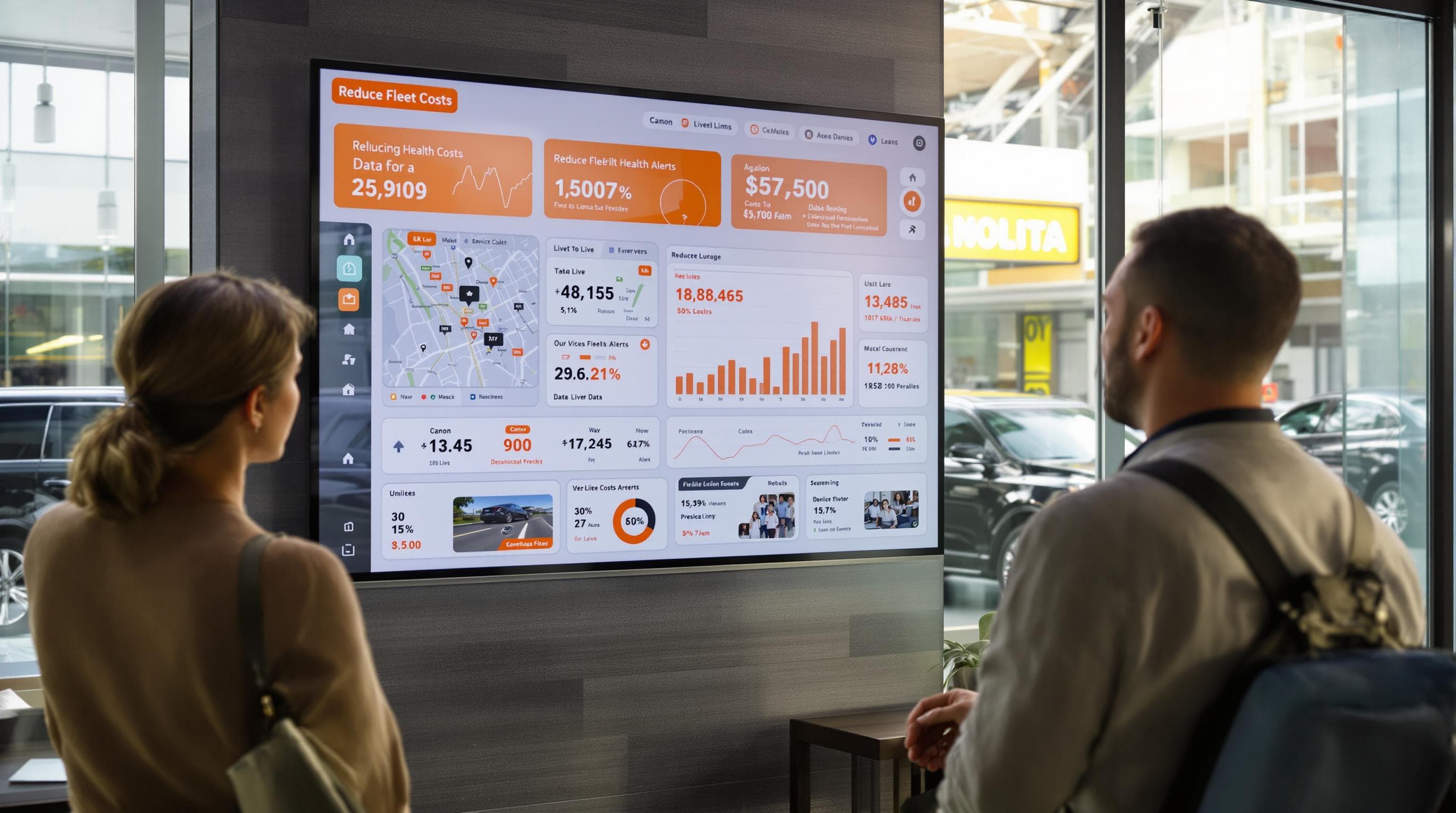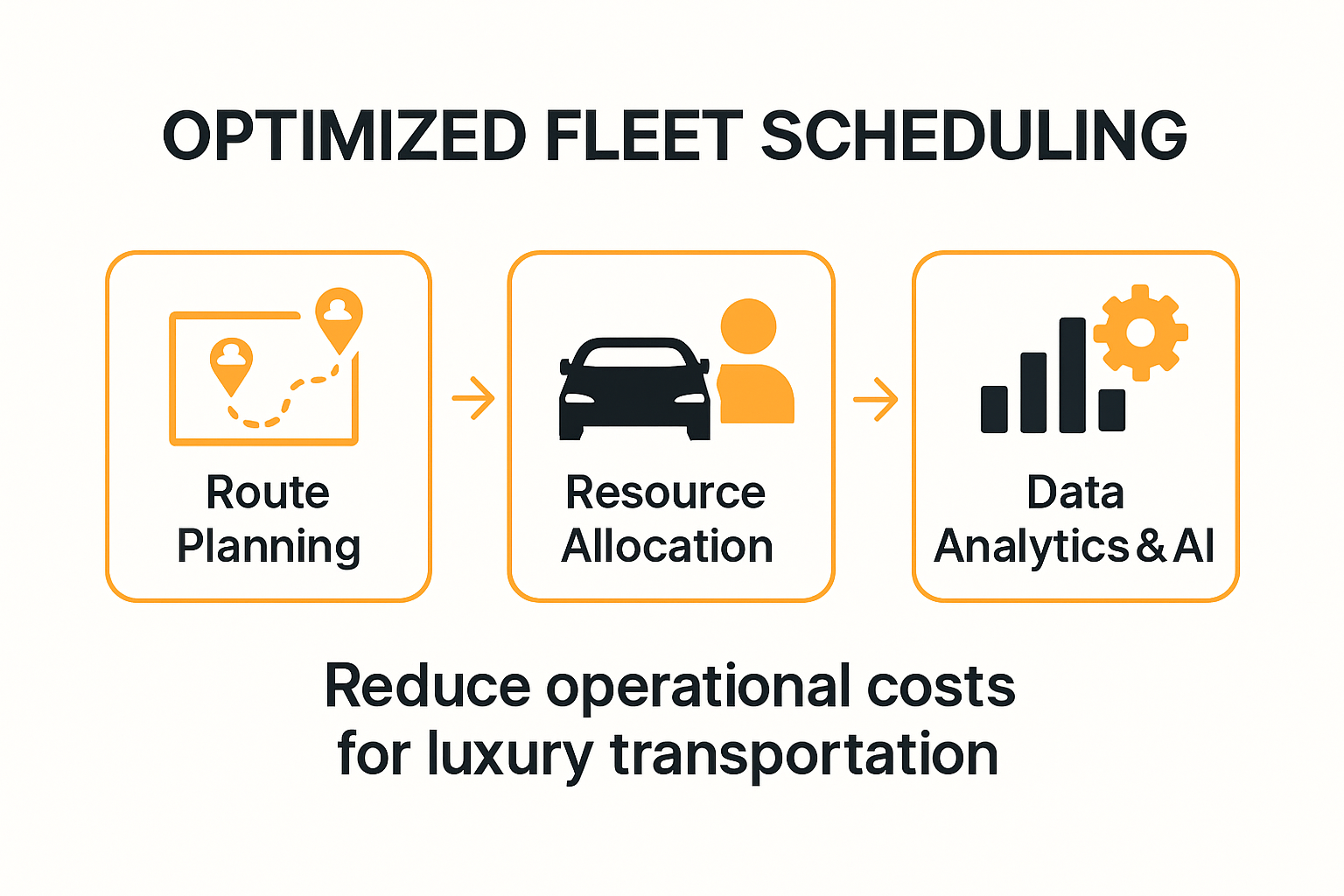How to Reduce Fleet Costs in 2025 for Luxury Limo and Transport Operators
How to Reduce Fleet Costs in 2025 for Luxury Limo and Transport Operators

Managing luxury limo and transport fleets isn’t just about keeping the cars running smoothly. Costs keep climbing and tight margins can make or break a business. Now look at this. Companies adopting advanced automation tools have slashed operational costs by up to 25 percent, according to Gartner. Most operators think trimming costs means cutting corners or lowering standards. The truth is that with the right strategies your fleet can actually run more efficiently and deliver even better service while spending less.
Table of Contents
- Optimizing Chauffeur And Vehicle Scheduling
- Leveraging Automation And Fleet Management Tools
- Reducing Maintenance And Fuel Expenses
- Smart Asset Utilization And Lifecycle Planning
Quick Summary
| Takeaway | Explanation |
|---|---|
| Optimize Scheduling | Use advanced dispatch strategies including historical trip data analysis and AI technologies to enhance vehicle and driver scheduling, minimizing operational expenses and improving fleet efficiency. |
| Implement Automation Tools | Leverage comprehensive digital fleet management tools to monitor vehicle performance, automate maintenance tracking, and analyze operational metrics, potentially reducing costs by up to 25%. |
| Reduce Maintenance and Fuel Costs | Adopt preventive maintenance strategies and optimize vehicle efficiency. Regular inspections, proactive scheduling, and fuel-efficient vehicles can lead to significant long-term savings. |
| Focus on Smart Asset Utilization | Utilize data-driven approaches for vehicle allocation and lifecycle planning, which includes monitoring performance metrics and establishing optimal replacement thresholds to enhance financial efficiency. |
| Emphasize Continuous Monitoring | Maintain a dynamic approach to fleet management that adapts to operational needs and leverages technology for informed decision-making to ensure ongoing cost-effectiveness and sustainability. |
Optimizing Chauffeur and Vehicle Scheduling
Effective scheduling represents the critical backbone of cost reduction for luxury transportation operators. By strategically managing vehicle and driver assignments, businesses can dramatically minimize operational expenses while maximizing fleet efficiency.
Intelligent Route Planning and Resource Allocation
Optimizing vehicle scheduling goes beyond simply assigning drivers to trips. Advanced dispatch strategies require a comprehensive approach that considers multiple variables simultaneously. According to research by Yu at the New Jersey Institute of Technology, successful vehicle routing models must account for total travel time, resource constraints, and operational efficiency.
Transportation businesses can implement several key strategies to improve scheduling precision. First, analyze historical trip data to identify peak demand periods and potential route optimization opportunities. This means mapping out typical customer flow, understanding geographic service patterns, and predicting potential idle times for vehicles and drivers.

Leveraging Technology for Scheduling Efficiency
Modern transportation companies are increasingly turning to artificial intelligence and machine learning to enhance scheduling capabilities. Chun's research on AI in vehicle scheduling demonstrates how constraint satisfaction algorithms can dramatically improve operational performance.
Key technological approaches include:
- Real-time GPS Tracking: Monitor vehicle locations and adjust routes dynamically
- Predictive Analytics: Forecast demand and preemptively allocate resources
- Automated Assignment Algorithms: Match drivers to trips based on proximity, availability, and specialized skills
By implementing these advanced scheduling techniques, luxury transportation operators can reduce fuel consumption, minimize unnecessary mileage, and optimize driver working hours. The goal is creating a seamless, efficient system that reduces operational costs while maintaining high-quality service standards.
Successful scheduling is not just about mathematical precision but also about creating a flexible, responsive operational framework that can adapt to changing market demands and unexpected challenges. Transportation businesses that master this approach will gain significant competitive advantages in an increasingly complex and technology-driven industry.
To better visualize the benefits of different scheduling technologies and strategies discussed, the following table compares their key features and cost-saving impacts:
| Technology/Strategy | Key Benefit | Cost-Saving Impact |
|---|---|---|
| Real-time GPS Tracking | Dynamic route adjustment, reduces idle time | Decreases fuel costs, boosts efficiency |
| Predictive Analytics | Accurate demand forecasting, resource allocation | Prevents over-deployment, saves labor/fuel |
| Automated Assignment Algorithms | Matches drivers by proximity/skills/availability | Minimizes empty mileage, cuts operational costs |
| Historical Trip Data Analysis | Identifies demand patterns, optimizes schedules | Reduces resource waste, boosts utilization |
Leveraging Automation and Fleet Management Tools

Automation represents a transformative strategy for luxury transportation operators seeking to dramatically reduce fleet costs and enhance operational efficiency. By integrating sophisticated fleet management tools, businesses can unlock unprecedented levels of performance optimization and financial savings.
Comprehensive Digital Fleet Management
Modern fleet management goes far beyond traditional tracking methods. Explore comprehensive dispatch solutions that provide real-time insights and automated control mechanisms. Digital platforms enable operators to monitor vehicle performance, driver behavior, and operational metrics with unprecedented precision.
Key areas of digital fleet management include:
- Maintenance Tracking: Automated systems that predict and schedule vehicle maintenance before critical failures occur
- Performance Analytics: Detailed reporting on fuel consumption, driver efficiency, and operational costs
- Compliance Management: Automated tracking of driver certifications, vehicle inspections, and regulatory requirements
Advanced Technological Integration
The integration of artificial intelligence and machine learning technologies is revolutionizing fleet management. Operators can now leverage predictive algorithms that anticipate maintenance needs, optimize routing, and identify potential cost-saving opportunities before they become apparent.
According to Gartner Research, businesses implementing comprehensive automation tools can expect to reduce operational costs by up to 25% through improved efficiency and data-driven decision-making. These technologies enable:
- Instant performance monitoring
- Predictive maintenance scheduling
- Real-time resource allocation
- Comprehensive cost tracking and analysis
The true power of automation lies in its ability to transform raw data into actionable insights. By implementing advanced fleet management tools, luxury transportation operators can create a more responsive, efficient, and cost-effective operational model. These technologies eliminate manual processes, reduce human error, and provide a level of operational transparency that was previously impossible.
Transformation requires a strategic approach. Successful implementation means carefully selecting tools that integrate seamlessly with existing systems, provide comprehensive reporting, and offer scalable solutions that can grow with the business. The most effective fleet management tools are those that not only track performance but actively help operators make more intelligent, cost-effective decisions.
Reducing Maintenance and Fuel Expenses
Maintaining a cost-effective fleet requires a strategic approach to managing maintenance and fuel expenses. Luxury transportation operators must implement comprehensive strategies that address both immediate operational costs and long-term financial sustainability.
Optimizing Vehicle Efficiency and Maintenance
Preventive maintenance strategies are crucial for reducing overall fleet expenses. According to the U.S. Department of Energy's Federal Energy Management Program, minimizing vehicle miles traveled (VMT) can significantly decrease petroleum use and operational costs.Key maintenance optimization techniques include:
- Regular Vehicle Inspections: Conduct comprehensive checks to identify potential issues early
- Proactive Maintenance Scheduling: Implement manufacturer-recommended service intervals
- Performance Monitoring: Track vehicle efficiency and address performance declines immediately
Strategic Fuel Cost Management
Fuel represents a substantial expense for transportation operators. Research from the University of Massachusetts Amherst highlights the importance of right-sizing vehicle specifications and considering alternative fuel options.
Effective fuel cost reduction strategies encompass:
- Selecting fuel-efficient vehicles tailored to specific operational needs
- Exploring electric and hybrid vehicle options
- Implementing anti-idling policies
The Federal Energy Management Program reveals that simple maintenance techniques can improve fuel economy by up to 2%. This includes:
- Regular engine tune-ups
- Using manufacturer-recommended motor oil
- Maintaining optimal tire pressure
- Installing idle-reduction technologies
Transportation businesses can achieve substantial cost savings by adopting a holistic approach to vehicle management. This means looking beyond immediate expenses and considering long-term efficiency. A 1-5 MPG improvement can translate into significant financial benefits, especially for medium and heavy-duty vehicle fleets.
Successful expense reduction requires continuous monitoring and adaptation. Operators must remain flexible, leveraging technology and data analytics to make informed decisions about vehicle maintenance, replacement, and operational strategies. By treating fleet management as a dynamic, evolving process, luxury transportation companies can create a more sustainable and financially efficient operational model.
The following table summarizes key maintenance and fuel cost reduction methods along with their specific benefits:
| Method | Description | Cost Saving Benefit |
|---|---|---|
| Regular Vehicle Inspections | Identify and fix issues early | Avoids major repairs, prevents downtime |
| Proactive Maintenance Scheduling | Service vehicles at recommended intervals | Extends asset life, lowers breakdown risk |
| Performance Monitoring | Track efficiency, detect performance drops | Maintains optimal MPG, reduces fuel costs |
| Selecting Fuel-Efficient/Alternative Vehicles | Use hybrid or right-sized vehicles | Cuts fuel use, may lower emissions |
| Implementing Anti-Idling Policies | Reduce unnecessary engine running | Saves fuel, limits wear and tear |
| Maintaining Proper Tire Pressure | Ensure tires are at optimal inflation | Can improve fuel economy up to 2% |
Smart Asset Utilization and Lifecycle Planning
Smart asset utilization represents a critical strategy for luxury transportation operators seeking to optimize fleet performance and minimize long-term operational expenses. By implementing sophisticated lifecycle planning approaches, businesses can dramatically improve financial efficiency and strategic resource management.
Strategic Asset Allocation and Deployment
Advanced fleet management techniques enable transportation operators to make data-driven decisions about vehicle acquisition, maintenance, and retirement. According to the U.S. Department of Energy's Federal Energy Management Program, establishing motor vehicle pools and implementing transportation-on-demand services can significantly reduce overall fleet costs.Key strategies for smart asset utilization include:
- Telematics Integration: Use data analytics to track vehicle performance and usage patterns
- Demand-Based Allocation: Match vehicle availability precisely with operational requirements
- Consolidated Vehicle Pools: Reduce total fleet size through strategic resource sharing
Lifecycle Management and Economic Optimization
Research from the University of Minnesota's Center for Transportation Studies emphasizes the critical importance of accurate data collection in determining optimal asset lifecycles. By analyzing comprehensive performance metrics, operators can make informed decisions about when to maintain, upgrade, or replace vehicles.Effective lifecycle planning involves:
- Tracking total cost of ownership
- Monitoring vehicle performance degradation
- Establishing precise replacement thresholds
- Considering technological advancements and efficiency improvements
According to telematics research, implementing sophisticated tracking can potentially reduce vehicle fuel use by 5% to 20%. This demonstrates how intelligent asset management goes beyond simple maintenance scheduling and transforms into a comprehensive strategic approach.
Modern transportation businesses must view their fleet as a dynamic ecosystem rather than a static collection of assets. Horizant Insights highlights that successful asset management incorporates sustainability practices, focusing on energy efficiency and responsible end-of-life disposal.
Ultimately, smart asset utilization is about creating a responsive, data-driven framework that balances immediate operational needs with long-term financial considerations. By adopting a holistic approach to lifecycle planning, luxury transportation operators can achieve unprecedented levels of operational efficiency, cost reduction, and strategic flexibility.
Frequently Asked Questions
How can luxury limo operators optimize scheduling to reduce costs?
Effective scheduling can be achieved by utilizing advanced dispatch strategies that analyze historical trip data, identify peak demand periods, and optimize vehicle routing. This minimizes operational expenses and maximizes fleet efficiency.
What role does automation play in reducing fleet costs?
Automation significantly enhances cost-efficiency by introducing comprehensive digital fleet management tools that monitor performance, automate maintenance tracking, and improve decision-making. Businesses can expect to reduce costs by up to 25% through effective automation.
How can maintenance and fuel expenses be minimized for luxury transport fleets?
Operators can minimize maintenance costs by implementing preventive maintenance strategies, conducting regular vehicle inspections, and using fuel-efficient vehicles. These practices help extend the life of the fleet and reduce overall fuel consumption.
What strategies can help in smart asset utilization and lifecycle management?
Key strategies include using telematics for performance tracking, demand-based vehicle allocation, and establishing precise replacement thresholds based on data analytics. This approach ensures optimal asset lifecycle management and cost reduction.
Ready to Slash Your Fleet Costs and Modernize Your Operations?
Luxury limo and transport operators know the stress of rising costs and tight margins. Operating an efficient, technology-driven fleet, as explained in this article, is no longer optional if you want to compete in 2025. Delays from manual scheduling, wasted fuel on inefficient routes, and administrative overhead are draining your budget. AtoZ Dispatch solves these pain points with automation, real-time trip management, and smart analytics wrapped into one easy platform, all while letting you keep your custom brand front and center. You do not need to compromise service quality in the pursuit of savings.

Take the next step toward true digital transformation and cost control. Skip weeks of guesswork and instantly boost your fleet's efficiency with AtoZ Dispatch’s free trial. Explore job automation, real-time tracking, driver and passenger apps, and integrated compliance features that keep your business running smarter—not harder. Discover why so many premium operators trust our comprehensive dispatch solutions to reduce expenses and maximize revenue. Try it now and see the difference for your business.
Recommended
- Insights | AtoZ Dispatch
- Digital Marketing for Chauffeur Services – Get More Bookings
- Dispatch Software Built Around Your Workflow
- Dispatch Software – All-in-One Dashboard for Limo & Chauffeur Operations– Manage Rides, Drivers, and Payouts
- How Car Premiums Are Calculated in 2025: Simple Guide - Savvy Insurance
- Equipment Rental vs Purchase: Smart Choices for Projects 2025 - Sterling Access

Comments
Post a Comment